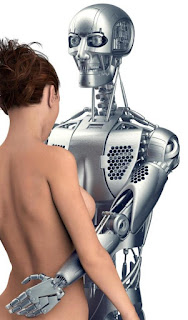Paolozzi,
the digital artist in a still-analogue age, had a fascination with robots,
especially around 1970. Nearly 50 years
on, these things are now frequently in the news as examples break through from
being laboratory projects into the everyday environment, for instance as
now-practicable housework ‘assistants,’ and, yikes, as functioning sexual partners. What was science fiction to us 1950s/60s/70s-dwellers
is fast becoming everyday reality.
Disappointingly, the aesthetics of realisation don’t compare well with
the imaginations of Fifties artists, Eagle’s
Frank Hampson for
instance, whose visualisation of the dashing man in space – Dan Dare – makes Apollo
moonwalker Buzz Aldrin look no more than a
lumbering, jazzed-up Michelin Man.
Likewise,
the primary-coloured tin and plastic toy robots of the Fifties appear much more
characterful than the rather sterile-looking models now emerging, (though in
regard to the sexually active ones, being hygienically sterile may well be a
very desirable attribute . . .)
Robots amongst a
sample of the collection of toys amassed over many years by Paolozzi
Sexbot as pictured in
the Sun, January 2017
But,
back to 1970, and it’s a bit awkward in the Artist’s studio since it looks as
if Eduardo’s chat-up lines were not impressing his mechanical companion:
Courtesy of Robin
Spencer (Eduardo Paolozzi: Writings and Interviews)
Paolozzi
said of the etchings series, Cloud Atomic
Laboratory, (1971):
The schism that
separates Space Age Engineering, technical photography, film making and types
of street-art from fine art activities is for many people/artists unbridgeable.
Within the grand
system of paradoxes, the theme of this portfolio is the Human Predicament.
Content enlarged by precision. History shaded into the grey scale as in the
television tube.
‘Le Robot Robert,’ is from the series:
© Trustees of the
Paolozzi Foundation
Below
is a detail of the 'Shelves of Readymades'
which was made for the 1971 Tate Paolozzi exhibition. This has been preserved within the Krazy Kat Archive kept at the V&A.:
Courtesy of Robin
Spencer (Eduardo Paolozzi: Writings and Interviews)
Much
convoluted theorising is valid about Paolozzi’s purpose in using robots as
subject matter – analogy with issues of control/subservience in a new technological-age,
for example – but he said something much more straightforward in 1960 talking
to Edouard Roditi:
. . . if one of us
(sculptors) chances to find a particularly nice and spooky-looking piece of
junk like an old discarded boiler, he can scarcely avoid using it as the trunk
or body of a figure, if only because its shape suggests a body to anyone who
sets out to do this kind of assembly work.
Then one only needs to weld something smaller onto the top to suggest a
head, and four limb-like bits and pieces onto the sides and the bottom to
suggest arms and legs, and there you have the whole figure, which has come to
life like a traditional Golem or robot . . .
This
late Seventies book with its strangely engaging cover image was referenced by
Paolozzi:
Paolozzi’s
interest in these things as subject matter was sustained through to near the
end of his career, as demonstrated by the most impressive sculpture, ‘Vulcan,’ installed
in the Dean Gallery, Scottish National Gallery of Modern Art:
© (c) Trustees of the
Paolozzi Foundation
And,
meanwhile, over at the National Museum of Scotland, some more Paolozzi robotic
creations keep guard of a collection of ‘early-man’ artefacts:
© National Museums
Scotland
Paolozzi had always liked to explore the juxtaposition of images and objects, contrasting the mundane with the deeply philosophical for example. I think therefore that he'd be particularly pleased with this installation.








